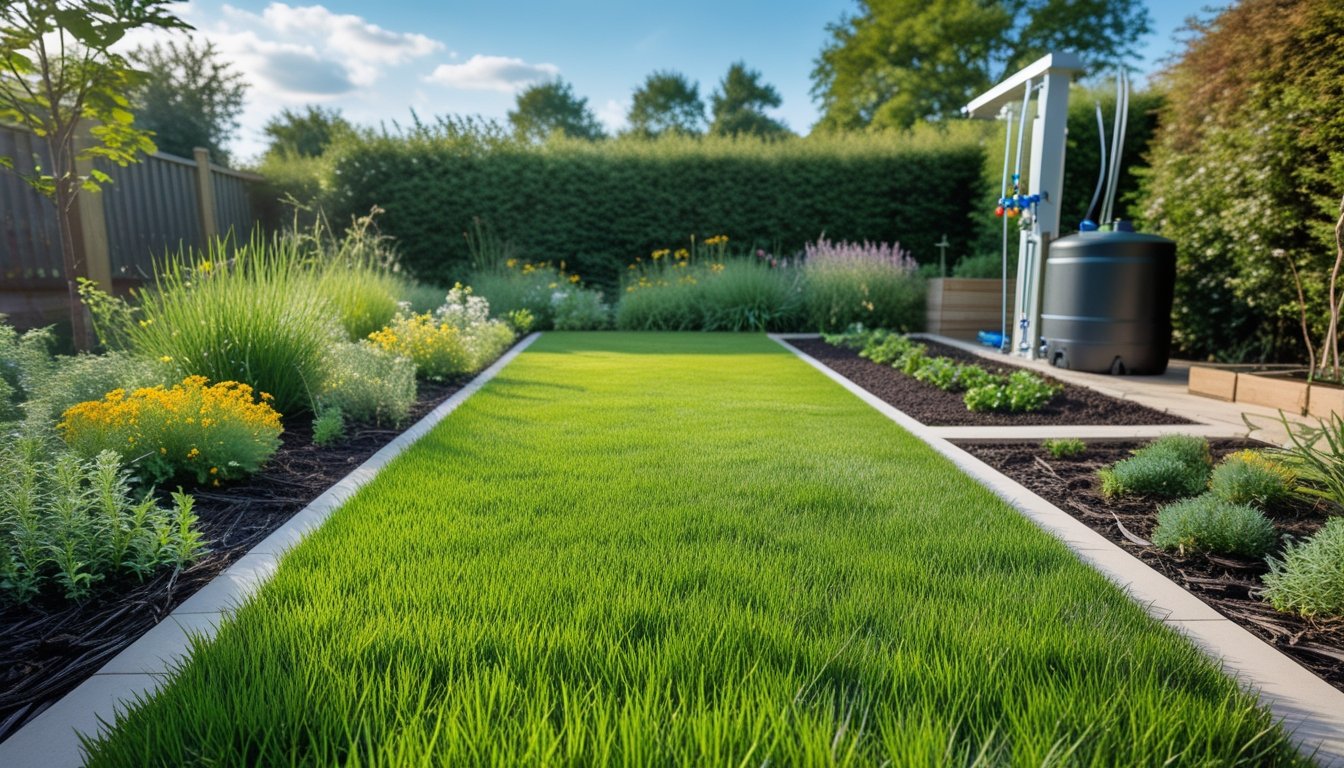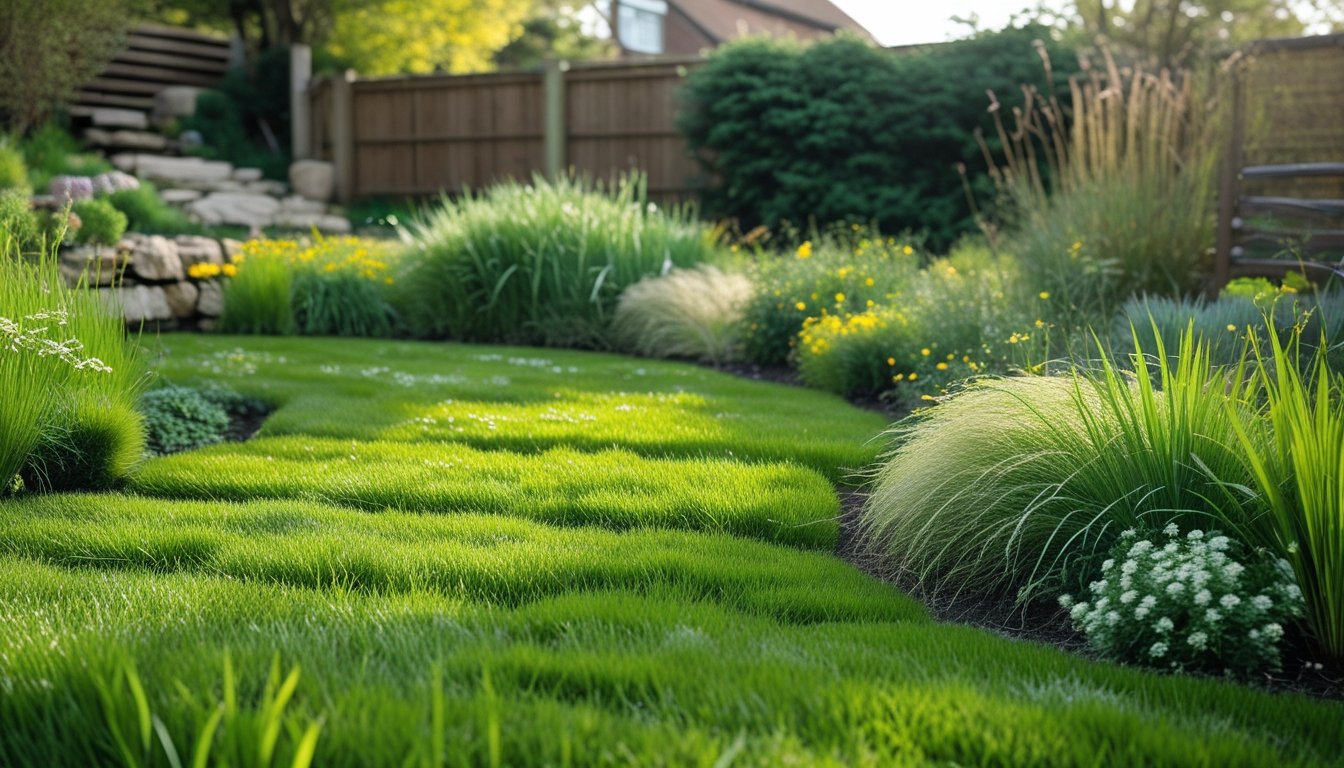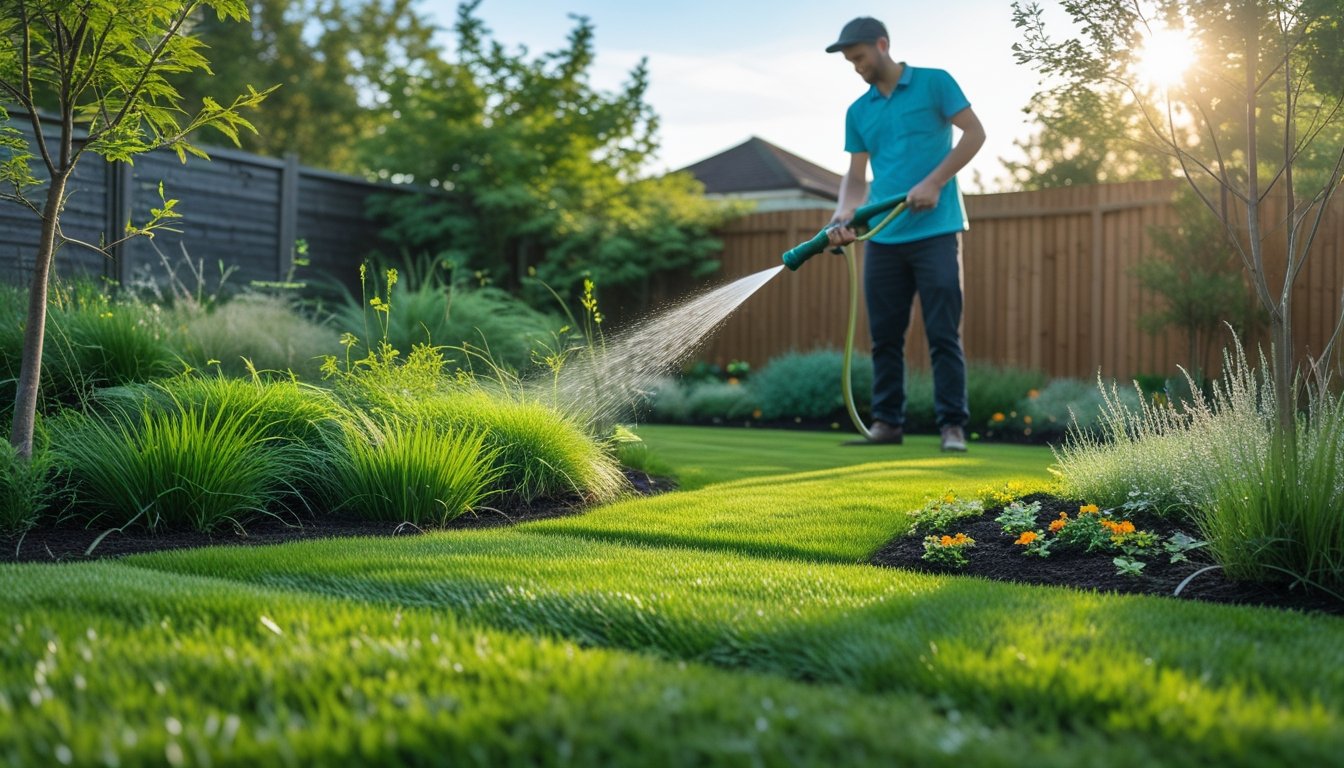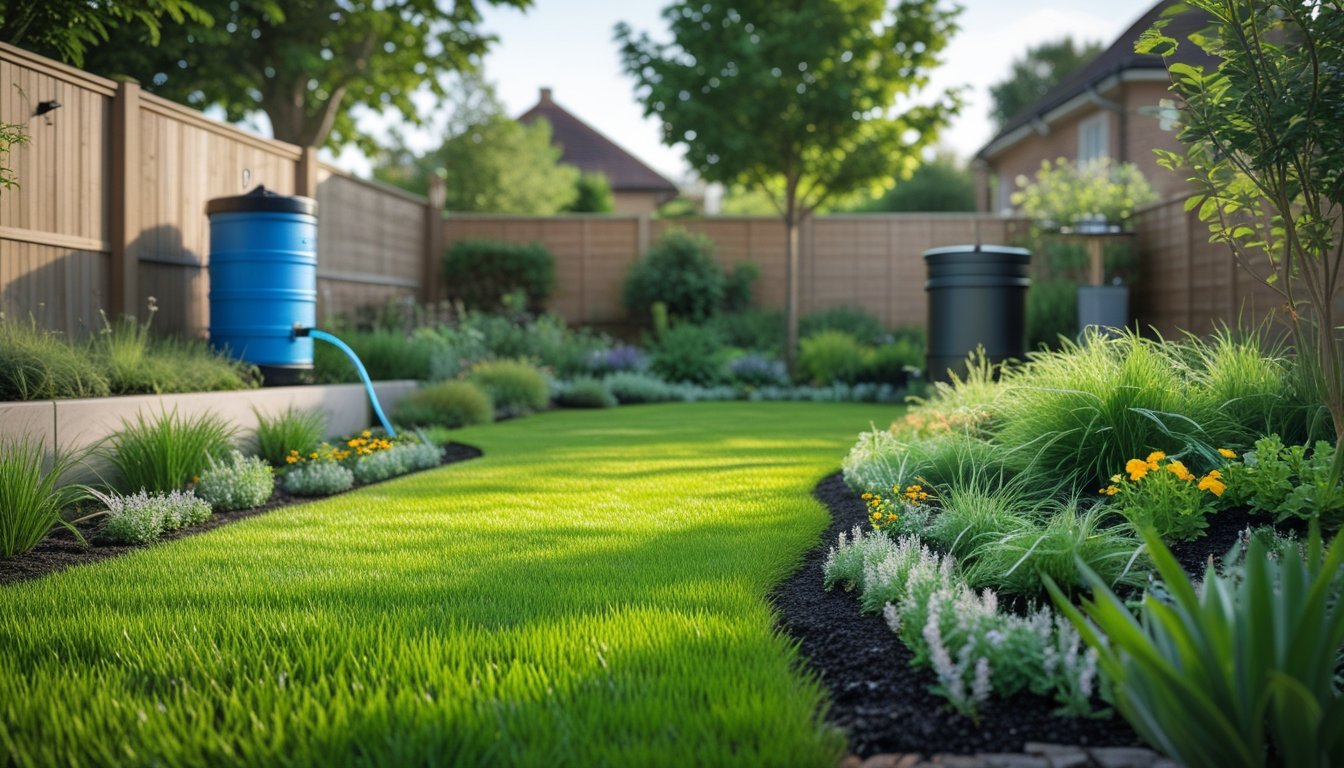Late updated: 25 Oct 2025 14:10
Written by: Emily Thornton
Creating A Native UK Lawn: Efficient Water Management Strategy
Creating a native UK lawn with minimal water usage is not only beneficial for the environment but also transforms our gardens into thriving, resilient ecosystems. By using UK-native plants, we can significantly reduce the need for constant watering and maintenance, making our outdoor spaces both beautiful and sustainable. Native species are already adapted to the local climate, ensuring they can withstand periods of drought while supporting local wildlife.

Throughout this post, we'll explore how to design, establish, and maintain a lawn that thrives on natural rainfall. Our approach will focus on practical strategies that minimise water consumption while ensuring a lush, green appearance. Whether you're an experienced gardener or just beginning, these insights will help you cultivate a lawn that aligns with ecological awareness.
Key Takeaways
- Native UK plants reduce the need for frequent watering.
- Design strategies can enhance sustainability and beauty.
- Simple maintenance practices support ongoing growth.
Key Principles for Creating a Native UK Lawn with Minimal Water Usage

Creating a native UK lawn focused on minimal water usage involves carefully selecting drought-tolerant species, understanding the local soil, using efficient mulching techniques, and implementing sustainable irrigation methods. These strategies can make it possible for us to achieve an eco-friendly and resilient lawn.
Selecting Drought-Tolerant Native Plants
Choosing the right plants is crucial for a sustainable lawn. We should focus on native, drought-tolerant species that are well adapted to the UK’s climate. These plants are resilient to dry spells and require less water once established. Species like Festuca rubra and Agrostis capillaris are excellent options.
Such grasses not only reduce water needs but also support local biodiversity. They attract pollinators like bees and butterflies, enhancing the ecological health of the area. Selecting the appropriate seed mix is essential for a lush lawn that thrives with minimal maintenance.
Understanding Soil Type and Preparation
Soil type directly affects water retention and plant health. It's essential for us to test soil to determine its composition—whether it’s sandy, clay, or loamy. Each type impacts drainage and nutrient availability differently.
Once we know the soil type, we can amend it accordingly before planting. For example, adding organic matter improves water retention in sandy soils and enhances drainage in clay soils. Proper soil preparation creates a conducive environment for drought-tolerant grasses, promoting robust root systems and healthy lawns.
Optimising Mulch and Mulching Techniques
Mulching plays a key role in conserving moisture and suppressing weeds. Organic mulches like bark chips or well-rotted compost are effective in retaining soil moisture and providing slow-release nutrients. We should apply a layer of mulch around the base of plants to optimise these benefits.
Seasonal mulching aligns with the weather conditions and the needs of the lawn. In the spring, it encourages growth, while in the summer, it protects against the heat. Effective mulching reduces evaporation and keeps the soil cool, ensuring that the lawn requires less water.
Eco-Friendly Irrigation Methods
Efficient irrigation is essential for water conservation. Using systems such as drip irrigation or soaker hoses delivers water directly to the roots of the plants, minimising waste through evaporation. These systems are particularly effective for newly established lawns requiring consistent moisture.
Timing is also crucial. Watering in the early morning decreases evaporation, allowing the lawn to absorb more moisture. Installing rain sensors can further optimise water usage by preventing unnecessary watering after rainfall. Through these innovative methods, we can significantly reduce water consumption while maintaining a robust, green lawn.
Designing, Establishing and Maintaining Your Native Lawn

A well-designed native lawn in the UK provides benefits such as enhanced biodiversity, efficient water usage, and minimal upkeep. Focusing on native plants ensures a harmonious balance between aesthetic appeal and environmental sustainability.
Promoting Biodiversity and Supporting Pollinators
To boost biodiversity and support pollinators, it's essential to incorporate a mix of native plants. Species like clover and wild thyme are ideal, attracting bees and butterflies while enhancing the ecosystem.
Strategically planting these species creates layered habitats, offering varied sources of food and shelter. Moreover, maintaining diverse plant life helps balance the local ecosystem naturally.
Strategic planting not only enriches biodiversity but also ensures that our lawn actively supports pollinators throughout the seasons, contributing to a healthier environment.
Utilising Native Groundcovers for Water Efficiency
Native groundcovers provide an excellent solution for maintaining water-efficient lawns. These plants, such as creeping cinquefoil and bugle, are well adapted to the UK's climate and require minimal watering.
Their dense root systems contribute to soil health, preventing erosion and retaining moisture naturally. This reduces the need for supplemental watering, especially during the dry season.
Integrating these groundcovers into the landscape plan promises sustainable growth while enhancing the visual appeal of our native lawn.
Weed Control and Minimal Intervention Strategies
Effective weed control in a native lawn focuses on minimal intervention. Utilising manual removal techniques ensures that beneficial plants remain unharmed.
Applying mulch around native groundcovers suppresses unwanted growth and helps retain moisture. We can also choose groundcovers that outcompete weeds for resources.
By emphasising natural methods over chemical solutions, we protect soil health, ensuring a balanced ecosystem where native plants thrive.
Pruning and Care for Sustainable Growth
Proper pruning helps maintain the lush appearance of a native lawn. Regular trimming of species like wild strawberry encourages fresh growth and prevents plants from becoming invasive.
Selective pruning ensures that all plants receive adequate sunlight and air circulation, promoting robust health. Attention to specific growth habits enhances the aesthetic value while supporting ecological diversity.
By following these care strategies, our native lawn remains vibrant and sustainable, showcasing the unique beauty of native UK plants.
Frequently Asked Questions

Our focus is on using native grass species, preparing the soil efficiently, and implementing smart irrigation techniques to create a sustainable UK lawn. We also explore seasonal maintenance schedules and alternatives to traditional lawns, all designed to minimise water usage while maintaining lawn health.
What are the most drought-tolerant grass species native to the UK?
Some native grasses that are resilient to drought include Festuca rubra (red fescue) and Agrostis capillaris (bentgrass). These species are well-suited to the UK climate and can thrive with less water, making them ideal for low-water lawns.
How can I prepare soil to minimise water consumption for a British garden lawn?
Improving soil structure is key. We recommend incorporating organic matter such as compost to enhance water retention. Additionally, ensuring proper aeration allows water to penetrate deeper, reducing surface evaporation and promoting healthier lawns with lower water needs.
What are effective methods for irrigating UK lawns with low water usage?
Utilising drip irrigation systems or soaker hoses can effectively reduce water waste. These methods deliver water directly to the soil, minimising evaporation. Watering early in the morning or late evening further ensures maximum absorption with minimal loss.
Could you suggest a seasonal maintenance schedule to sustain a healthy lawn with minimal watering?
Spring: Aerate and add compost. Summer: Water during cooler parts of the day. Autumn: Lightly fertilise and decrease watering as temperatures drop. Winter: Allow the lawn to rest, eliminating the need for frequent watering while maintaining minimal activity.
What alternatives to traditional lawns are suited to British climates and require less water?
Consider native wildflower meadows or clover lawns. They are not only low in maintenance but also support biodiversity. These alternatives require significantly less water than traditional lawns and remain visually appealing throughout the year.
How often should I water my lawn in the UK to conserve water whilst maintaining its quality?
Watering once every 7-10 days should suffice during dry spells. Adapt to weather patterns; less frequent but deep watering encourages strong root development. Monitoring the lawn’s response to watering can help fine-tune the schedule.
